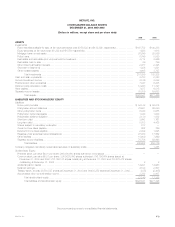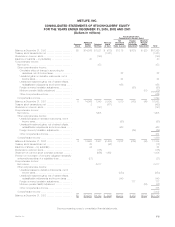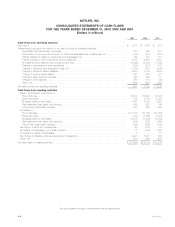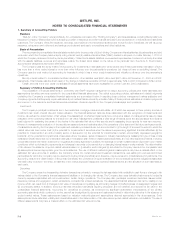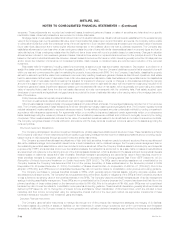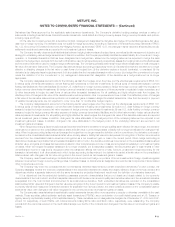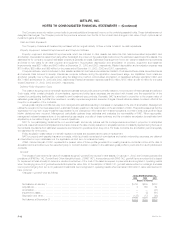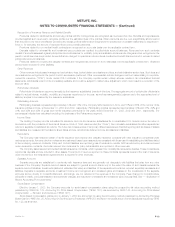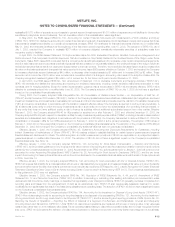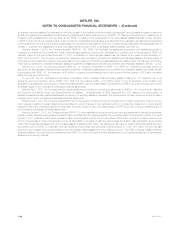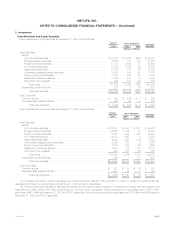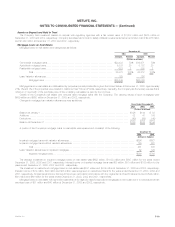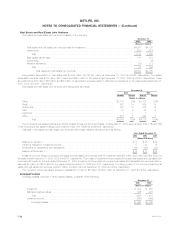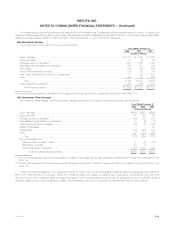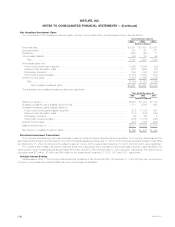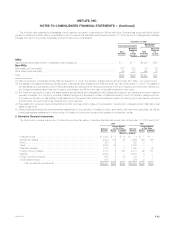MetLife 2003 Annual Report Download - page 58
Download and view the complete annual report
Please find page 58 of the 2003 MetLife annual report below. You can navigate through the pages in the report by either clicking on the pages listed below, or by using the keyword search tool below to find specific information within the annual report.METLIFE, INC.
NOTES TO CONSOLIDATED FINANCIAL STATEMENTS — (Continued)
Recognition of Insurance Revenue and Related Benefits
Premiums related to traditional life and annuity policies with life contingencies are recognized as revenues when due. Benefits and expenses are
provided against such revenues to recognize profits over the estimated lives of the policies. When premiums are due over a significantly shorter period
than the period over which benefits are provided, any excess profit is deferred and recognized into operations in a constant relationship to insurance in-
force or, for annuities, the amount of expected future policy benefit payments.
Premiums related to non-medical health contracts are recognized on a pro rata basis over the applicable contract term.
Deposits related to universal life and investment-type products are credited to policyholder account balances. Revenues from such contracts
consist of amounts assessed against policyholder account balances for mortality, policy administration and surrender charges and are recognized in the
period in which services are provided. Amounts that are charged to operations include interest credited and benefit claims incurred in excess of related
policyholder account balances.
Premiums related to property and casualty contracts are recognized as revenue on a pro rata basis over the applicable contract term. Unearned
premiums are included in other liabilities.
Other Revenues
Other revenues include asset management and advisory fees, broker/dealer commissions and fees, and administrative service fees. Such fees and
commissions are recognized in the period in which services are performed. Other revenues also include changes in account value relating to corporate-
owned life insurance (‘‘COLI’’). Under certain COLI contracts, if the Company reports certain unlikely adverse results in its consolidated financial
statements, withdrawals would not be immediately available and would be subject to market value adjustment, which could result in a reduction of the
account value.
Policyholder Dividends
Policyholder dividends are approved annually by the insurance subsidiaries’ boards of directors. The aggregate amount of policyholder dividends is
related to actual interest, mortality, morbidity and expense experience for the year, as well as management’s judgment as to the appropriate level of
statutory surplus to be retained by the insurance subsidiaries.
Participating Business
Participating business represented approximately 14% and 16% of the Company’s life insurance in-force, and 57% and 55% of the number of life
insurance policies in-force, at December 31, 2003 and 2002, respectively. Participating policies represented approximately 38% and 38%, 39% and
41%, and 43% and 45% of gross and net life insurance premiums for the years ended December 31, 2003, 2002 and 2001, respectively. The
percentages indicated are calculated excluding the business of the Reinsurance segment.
Income Taxes
The Holding Company and its includable life insurance and non-life insurance subsidiaries file a consolidated U.S. federal income tax return in
accordance with the provisions of the Internal Revenue Code of 1986, as amended (the ‘‘Code’’). Non-includable subsidiaries file either separate tax
returns or separate consolidated tax returns. The future tax consequences of temporary differences between financial reporting and tax bases of assets
and liabilities are measured at the balance sheet dates and are recorded as deferred income tax assets and liabilities.
Reinsurance
The Company has reinsured certain of its life insurance and property and casualty insurance contracts with other insurance companies under
various agreements. Amounts due from reinsurers are estimated based upon assumptions consistent with those used in establishing the liabilities related
to the underlying reinsured contracts. Policy and contract liabilities are reported gross of reinsurance credits. DAC is reduced by amounts recovered
under reinsurance contracts. Amounts received from reinsurers for policy administration are reported in other revenues.
The Company assumes and retrocedes financial reinsurance contracts, which represent low mortality risk reinsurance treaties. These contracts are
reported as deposits and are included in other assets. The amount of revenue reported on these contracts represents fees and the cost of insurance
under the terms of the reinsurance agreement and is reported in other revenues.
Separate Accounts
Separate accounts are established in conformity with insurance laws and are generally not chargeable with liabilities that arise from any other
business of the Company. Separate account assets are subject to general account claims only to the extent the value of such assets exceeds the
separate account liabilities. Investments (stated at estimated fair value) and liabilities of the separate accounts are reported separately as assets and
liabilities. Deposits to separate accounts, investment income and recognized and unrealized gains and losses on the investments of the separate
accounts accrue directly to contractholders and, accordingly, are not reflected in the revenues of the Company. Fees charged to contractholders,
principally mortality, policy administration and surrender charges, are included in universal life and investment-type products fees. See ‘‘— Application of
Recent Accounting Pronouncements.’’
Stock-Based Compensation
Effective January 1, 2003, the Company accounts for stock-based compensation plans using the prospective fair value accounting method
prescribed by SFAS No. 123, Accounting for Stock-Based Compensation (‘‘SFAS 123’’), as amended by SFAS 148, Accounting for Stock-Based
Compensation — Transition and Disclosure (‘‘SFAS 148’’).
Stock-based compensation grants prior to January 1, 2003 are accounted for using the accounting method prescribed by Accounting Principles
Board Opinion (‘‘APB’’) No. 25, Accounting for Stock Issued to Employees (‘‘APB 25’’) and Note 14 includes the pro forma disclosures required by SFAS
No. 123, as amended.
MetLife, Inc. F-13


